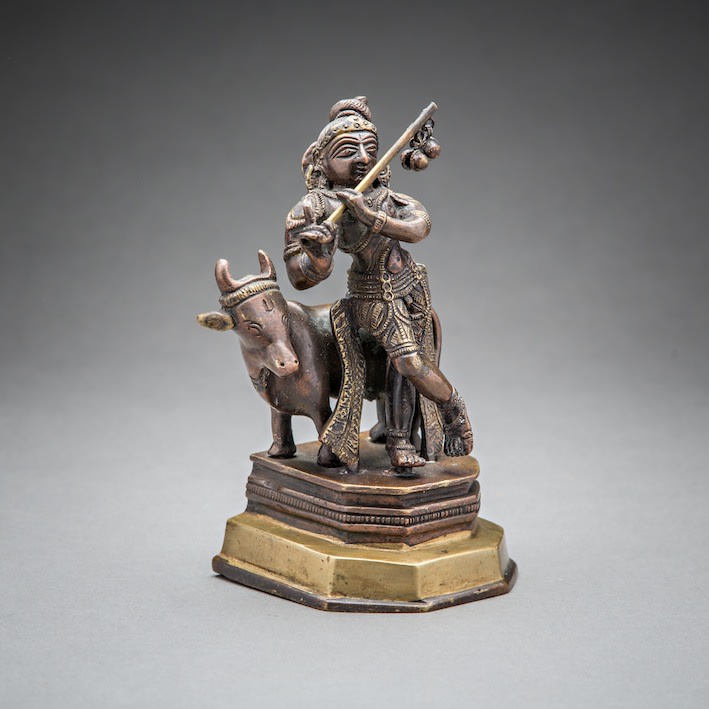Statue of Krishna Playing the Flute, 19th Century CE - 20th Century CE
Bronze/Brass
15.9 x 10.2 cm
6 1/4 x 4 in
6 1/4 x 4 in
SF.092
Further images
Krishna is a Hindu deity often depicted as a young man playing the flute. In some Hindu traditions he is regarded as an incarnation of Vishnu. According to ancient epics,...
Krishna is a Hindu deity often depicted as a young man playing the flute. In some Hindu traditions he is regarded as an incarnation of Vishnu. According to ancient epics, such as the Mahabharata, he was born of royal parents, the princess Devaki and her husband Vasudeva. Devaki’s brother had previously seized the throne unlawfully and deposed their father. A prophecy warned him that one of Devaki’s children would seek revenge for this unlawful act so he tried to obliterate them. Krishna escaped and was brought up by foster parents, Yasoda and Nanda in Gokul. Nanda was the head of a community of cow-herders hence the iconography of the present piece. Krishna became known as ‘Govinda’ (finder of cows) or ‘Gopala’ (protector of cows) and is often depicted leaning against a standing cow. Other traditions illustrate him surrounded by milkmaids.
In this piece the divine herdsman raises his flute to his lips, the end of which is hung with bells. He stands in a relaxed pose with his right leg bent at the knee and his left foot raised off the ground, clearly resting his weight on the cow. The gilded details of his dhoti are extraordinary and he is also heavily adorned with jewellery, presumably reflecting his royal background. A sense of movement is implied by the headdress which leans towards the figure’s right. Both figures stand on an octagonal two-tiered brass base. This is a charming and detailed piece in excellent condition. The technique of working in two metals is referred to as 'Ganga Jumna', and represents the meeting of the Ganga and Jumna rivers in India. (AM)
In this piece the divine herdsman raises his flute to his lips, the end of which is hung with bells. He stands in a relaxed pose with his right leg bent at the knee and his left foot raised off the ground, clearly resting his weight on the cow. The gilded details of his dhoti are extraordinary and he is also heavily adorned with jewellery, presumably reflecting his royal background. A sense of movement is implied by the headdress which leans towards the figure’s right. Both figures stand on an octagonal two-tiered brass base. This is a charming and detailed piece in excellent condition. The technique of working in two metals is referred to as 'Ganga Jumna', and represents the meeting of the Ganga and Jumna rivers in India. (AM)





